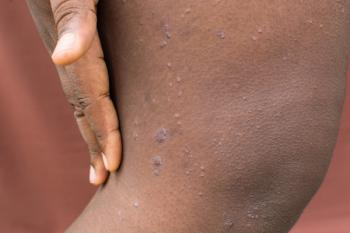
Researchers Identify Potential Biomarkers for Combination Treatment Efficacy in NSCLC
A recent study demonstrates certain driver mutations in patients with non–small cell lung cancer (NSCLC) may shorten disease-free survival after combination neoadjuvant immunotherapy and chemotherapy.
Undergoing comprehensive genomic profiling prior to administration of combination neoadjuvant immunotherapy and chemotherapy is crucial among patients with early-stage operable non–small cell lung cancer (
In individuals with stage II or III NSCLC, tumor relapse poses a major challenge. Although neoadjuvant chemotherapy has been shown to significantly improve overall survival in those with operable NSCLC, this benefit is small (6% 5-year overall survival rate) and creates the need for novel innovative drug combination strategies, researchers explained.
Current evidence regarding predictive biomarkers in NSCLC is controversial. To address this knowledge gap, investigators set out to analyze treatment outcomes of those who took neoadjuvant pembrolizumab and underwent chemotherapy. In addition, they assessed the association of treatment efficacy with predictive biomarkers, including programmed death-ligand 1 (PD-L1) expression level and genomic alterations.
A total of 23 patients who received a diagnosis of stage I to III NSCLC at a single hospital between January 2017 and December 2020 were included in the retrospective review. Radiologic and pathological criteria were used to assess tumor response to neoadjuvant therapy, while disease-free survival was calculated from date of surgery until date of radiological progression or death.
In addition, “next-generation sequencing was performed in case sufficient preoperative biopsy specimens were obtained.”
Eleven patients received preoperative neoadjuvant pembrolizumab and chemotherapy (combination group) and 12 received neoadjuvant chemotherapy only (chemotherapy group). Median patient age was 63.8 years, and the majority (n = 18) were male. Eleven patients had adenocarcinoma and the remainder had squamous cell carcinoma.
The median follow-up period was 18.3 months.
Analyses revealed:
- The radiological objective response rate (ORR) in the combination and chemotherapy groups was 45.5% and 58.3%, respectively (P = .537).
- For pathological assessment, the combination group had a significantly higher major pathological response (MPR) rate (63.6%) than the chemotherapy group (8.3%) (P = .005).
- The combination group had a significantly higher pathological complete response (pCR) (27.3%) rate than the chemotherapy group (0%) (P = .052).
When assessing potential biomarkers and treatment efficacy, researchers found the following:
- 3 patients in the combination group experienced disease recurrence and had high PD-L1 expression in preoperative biopsy specimens; among them, 2 patients had an MPR in postoperative assessment.
- Next-generation sequencing showed all 3 patients had targetable driver mutations, including an EGFR exon 20 insertion, complex EGFR mutation (exon 21 L858R substitution and exon 18 E709G substitution), and MET exon 14 skipping (splice donor site mutation).
- 2 of these patients harbored MET amplification, with copy number gains of 2.89 and 3.94, respectively.
- A significantly lower frequency of targetable driver mutations were seen among the remaining 8 patients with a disease-free status during the follow-up period.
- 1 of these patients had a targetable driver mutation (EGFR exon 21 L858R substitution) and EGFR amplification (copy number gain 10.23) (P = .007).
Taken together, results indicate the combination of neoadjuvant immunotherapy and chemotherapy should be the mainstay strategy for patients with early-stage NSCLC, authors wrote.
Because the PD-L1 expression levels varied widely among patients in the current study, future research is warranted to better assess the association of this potential biomarker with pathological response.
However, based on the researchers’ knowledge, “this is the first study to demonstrate that an EGFR exon 20 insertion or MET exon 14 skipping can shorten the disease-free survival after administration of the combination of neoadjuvant immunotherapy and chemotherapy,” they said, adding that “future studies should investigate better neoadjuvant therapy for patients with targetable driver mutations.”
The relatively low tumor mutation burden seen in patients with EGFR, ALK, ROS1, and RET mutations could serve as a possible explanation of decreased immune checkpoint inhibitor efficacy. Furthermore, presence of these driver mutations is linked with an immunosuppressive tumor environment.
The study’s small sample size and single-center nature mark limitations, as well as that all patients included also had good performance status.
Overall, “among patients with operable stage II to IIIA NSCLC preoperatively receiving the combination of neoadjuvant immunotherapy and chemotherapy, the presence of targetable driver mutations may be associated with early recurrence,” authors concluded.
“Therefore, comprehensive genomic profiling might have important role in patients with early-stage NSCLC. Future prospective studies are warranted to validate our findings,” they said.
Reference
Su P, Chen J, Chu C, et al. The impact of driver mutation on the treatment outcome of early-stage lung cancer patients receiving neoadjuvant immunotherapy and chemotherapy. Sci Rep. Published online February 28, 2022. doi:10.1038/s41598-022-07423-w
Newsletter
Stay ahead of policy, cost, and value—subscribe to AJMC for expert insights at the intersection of clinical care and health economics.








































